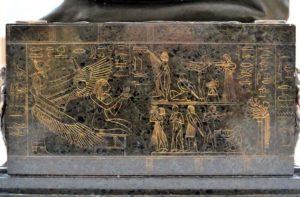Udja.
Uben Nefer Nehast
Next stop on this Journey; THE INITIATION.



A trip is planned for October. The Initiate will study some of the sites that contain wisdom about Musicians. She will present a concert on the Nile. And she will attend the Celestial Event on October 22 when the Sun shines on Ramses for 22 minutes. This blog post is about the preparations and research for this pilgrimage.


Learn more about Ancient African Adorations and Devotional World Music
What exactly am I seeking? I don’t really know yet, but when I find it, surely, a song will follow….


Here are a few things I found at a website on history of music theory
The Ancient Egyptians believed that understanding music was the key to understanding the cosmos. The idea of opposites pervaded all aspects of Egyptian knowledge and the understanding and perception of harmony was believed to be an important experience of understanding ratios and the simultaneity of opposites.
Musical harmonies were based on proportion, and the design of Ancient Egyptian architecture was also based on proportion. Egyptians considered music as a type of geometry translated into sound, and that architectural proportion underlies all harmonies




Egyptians believed in the concept of the ‘infinity of sound’, and divided up the infinity of sound into three distinct categories. Musicians are aware of two forms of sound: regular vibrations (pitch) and random vibrations (noise). Tehuti was the first to recognize a third element – of muting, being the absence of sound. Muting is a common skill employed by professional musicians to contain the sound
Egyptian Harps were used mostly in religious rituals and ceremonies. Musical notes in ancient Egypt were regarded as spiritual elements, and were conceived as independent structural entities. The Egyptian ten string harp was played by priests and it was regarded as a sacred instrument.
Egyptians believed that letters and words were phonetic elements with each individual letter as a picture of its own sound.They believed that individual letters consisted of unique vibrational patterns
this same site had some info on Pythagoras, and stated that he studied in Kemet for 21-23 years.
- Pythagoras believed that everything in the universe was related to numbers and mathematics. He believed that all numbers had an important spiritual and holy significance and tht each one carried its own vibration. He saw music the same way that he viewed geometry and mathematics, as a holy, spiritual scientific endeavor, of which a perfect society could be created.
- He believed that music should be regarded as a holy science and should never be used for mere entertainment purposes. He recognized music as the unifying principle of Harmonia, which he regarded as a divine principle that brings order to chaos and discord, which is also a reconciliation of opposing principles. Harmonia was one of the main principles of design and creation used in Egyptian architecture.
a very good place to start…
A List of the Places we will visit October 15-25.
Cairo Pyramids
Mini Tomb of Beni Hassan
Abydos Temple of Seti
I think I saw Meryt here….
Dendera HetHeru/Hathor Temple of Love, Music, Motherhood, and Dance
Ihy God of Music , Son of HetHeru
Luxor Valley of Kings and Queens
Aswan
Philae Temple of Aset
Abu Simbel Temple Festival October 22


What is the Abu Simbel Sun Festival?
The Abu Simbel Sun Festival is a bi-annual event that takes place at the spectacular temple of Ramses II in the south of Egypt. On two days of the year the central chamber of the temple is illuminated by the sun. For a short period of time as the sun perfectly aligns with the usually shrouded interior, light is cast on the seated statues of Ramses II (pharaoh), Ra (sun god) and Amun (king of the gods). Only the statue of Ptah, the god of darkness, remains in the shadows. This event has been taking place for over 3,200 years.
Thee is still time to join us! Contact Tchya at cosmic at tchiya.com
HOTEP!!!















